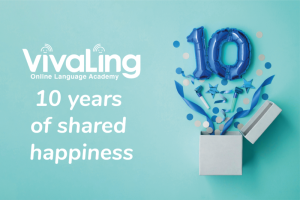Whether in a professional or personal context, it is often useful to be able to introduce yourself and start a conversation with a new person. What are the usual terms and expressions used to introduce oneself in English? How can you arouse the curiosity of your interlocutor and make a good impression (because the first image you convey is often crucial)?
Coach Tom reveals his best “tricks” for an effective and 100% British presentation!
And find all the VivaLing Podcasts for learn English on the VivaLing blog, or on Spotify or Itunes Store !
********************
And here is the script of the Podcast for those who would also like to improve their “Reading skills” 🙂
Let me introduce myself !
It can be tricky to introduce yourself with confidence in another language. Follow these tips in this new podcast!
Welcome back to the VivaLing “Let me Introduce Myself” Podcast. Before we get down to the content of the podcast, I want to look at a famous quote about the joys of introducing yourself and meeting new people. This is a famous quote by which of the following famous people: Napoleon Bonaparte, the famous French general and leader, Genghis Khan, a notorious Mongolian King, famous for creating the largest empire ever known to man or Julius Caesar, the great Roman. The quote is, “One of the joys of travel is visiting new towns and meeting new people.”
I have to say I agree with these sentiments, and if you can introduce yourself more effectively, the joys will be even greater. The answer will be at the end of this podcast.
Here you are, sitting round a table, waiting in an online conference.
The organiser, the teacher says, “I`d like to ask everyone to start off by saying a few words just so we can get to know you a little.” If this situation makes you nervous, you are not alone. We all know that first impressions count.
Let me tell you a story about a friend of mine. His name is Simon. He`s an excellent professional. He works in IT, that is information technology, as a systems analyst. Wow!
Well, for some reason, every time he introduced himself at a meeting or a conference, he couldn’t understand why people avoided eye contact, and the conversation never really got going.
I asked him how he introduced himself, and he said it went a bit like this.
“Hi, I`m Simon. I work in IT as a systems analyst, you know, working on the programmes, things like that. It`s good.”
I think you can see the problem. A systems analyst is not actually a boring job, but a lot of people think it is. Simon was just reinforcing the stereotype of himself as a computer nerd. No wonder that people didn’t want to continue the conversation.
So, we sat down and I made him learn a new intro and trained him to say it with enthusiasm.
“Hi, I`m Simon. I`m the one who helps people and companies make sure that their computers are working properly. So, I`m pretty busy and everyone loves me.“
Since using this intro, Simon has been given a better salary, got married to a beautiful woman, been offered a job on national TV as a computer expert and he might even be voted Time magazine Person of the Year. By the way, some of these consequences might be exaggerations.
But what makes Simon`s new intro so much better? He focuses on what he does in real terms, how he helps others and uses natural language in an enthusiastic way.
There are also a few questions and expressions you should be careful with when you meet people for the first time.
For example, what is the difference between, “How are you?” and, “How do you do?”
The correct answer to, “How are you?” could be anything from, “I`m feeling on top of the world” or “Over the moon” to “To be honest, I’ve been a bit down in the dumps lately,” but it`s probably best not to be too negative if you are meeting people for the first time.
There is, however, only one answer to, “How do you do?” You must reply by repeating the question. Thus, the dialogue goes like this.
Good afternoon, Mr Smith. Pleased to meet you. How do you do?
How do you do ? It’s a pleasure to be here.
This is a formal expression which should not be answered. It is really just a formula to be used to acknowledge a new acquaintance. Although it is quite old fashioned, it is still used a lot.
A good introduction should include the following :
1. your name
2. a description of what you do – as with the Simon example
3. where you live and how long you`ve been there – Use the present perfect. It will impress listeners that your grammar is so good.
4. an ending – There`s nothing less inspiring than someone just slowing down, not being able to think what to say next and say, “Err, uh, sorry, uh, that`s it.”
Imagine VivaLing was a person.
Here is a good introduction and a bad one. It should be easy for you to tell which is which.
“Hi. My name`s VivaLing. I help people of all ages communicate in different languages by connecting coaches with students. I was born in Singapore, but I’ve been getting bigger every year. What else would you like to know about me?”
“Hi. I`m VivaLing. I`m a school for people who want to … learn languages. I don`t really live in one place. We … use … computers, too. Uh, sorry. Where, where was I? That, that, that wasn’t very good, was it?”
At the risk of sounding like a self-help guru, let`s finish with a call for action.
1. Write a script and memorise it.
2. Practise saying it by heart.
3. Make eye contact.
4. Smile.
And most important of all, practice with your VivaLing Coach. Check your self introduction with your coach or compare them with other learners on our Facebook page.
But, before I say goodbye, let’s not forget the question from the beginning of this podcast. There was a quote. The quote was, “One of the joys of travel is visiting new towns and meeting new people.” This quote was something that the famous military leader Genghis Khan once said. I hope that with your introductions, you don’t make yourself like Genghis Khan. Although, considering he was one of the most successful people ever in the history of the world, it wouldn’t necessarily be a bad thing.
You can check your self introductions with your coach or compare them with other learners on our Facebook page.





